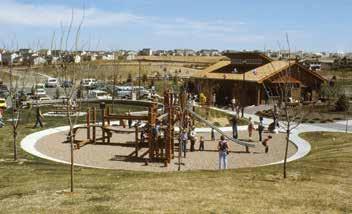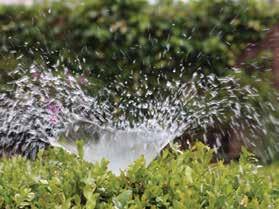
5 minute read
recreation programs 12-21 Highlands ranch’s 40th anniversary
26 parks 2,650 acres of open space 70+ miles of trails 98,000 people
40 years of building a unique community
Then and now at Northridge Park
Northridge Park, 8800 S. Broadway, opened in 1982 as the first park in our community. The photo below taken during the dedication celebration that year, shows newly planted trees, which over the years have grown into a large, beautiful canopy. View more vintage pictures of Highlands Ranch at highlandsranch.org/40thanniversary.


Did you know...
Highlands ranch and douglas county have received many accolades over the last few decades . our community has been named among the healthiest communities in the nation and among the best places to live
over the years . learn more about our community’s national recognition at highlandsranch.org/community-recognition .
Timeless beauty on display at the Mansion
This year the Highlands Ranch Mansion is celebrating its 130th anniversary, and one of the oldest pieces inside the historic estate is a stately grandfather clock in the living room.
The clock is believed to have been built in the early 1900s and sold by Walter Durfee, who was known for his clock line of unequaled quality. The wooden case was hand carved in Italy and features 14 cherub faces in addition to two winged angels on the sides. The clock measures approximately 5.5 feet tall and was built into the studs of the room. While it looks quite imposing and heavy, much of it is hollow.
“It is such a stunning piece, and completely unique to the Mansion. Its cheerful Westminster chimes and bells have been echoing through the building’s halls for almost a century now,”said Susie Appleby, volunteer and historic programs coordinator. Among other delicate details, a phrase is inscribed across the bottom of the wall clock and is from Dante’s Divine Comedy. The saying roughly translates to, “Time passes, but man perceives it not.”
Fence replacement enhances community parkways
More than 42 miles of Metro District-owned parkway fence winds through the community along major two-, four-, and six-lane arterial roads in Highlands Ranch. Each year, sections of fence are identified for replacement in order to keep our arterial roads looking beautiful. Additionally, Metro District staff perform annual maintenance including post repairs and staining.
Approximately 28,000 feet of Metro District-owned fence, listed below, is scheduled to be replaced late this year and early next year. Adjacent homeowners will be notified in advance.
2021
• Both sides of Venneford Ranch Road, from University Boulevard to Colorado Boulevard • Both sides of Colorado Boulevard north of University Boulevard • Both sides of S. Ranch Road • West side of Lucent Boulevard from Town Center Drive to
Highlands Ranch Parkway
2022
• Both sides of Wildcat Reserve Parkway from Highlands Ranch
Parkway to S. Broadway
Sign of great things

during february, two new community monument signs were installed along c-470 . the signs are located on the south side of the highway, with one east of S . broadway and the other west of colorado boulevard . the new double-sided signs are 28 feet long and are easily visible from the highway to help identify our vibrant community .
Protect your pets to minimize coyote conflicts
During spring along the Front Range, it is not abnormal to see coyotes during the day. Our close proximity to wildlife makes it important to understand how to avoid conflicts with coyotes and keep your pets safe.
Coyotes pair up during the spring breeding season, den and typically give birth to pups in April. During this time, male coyotes will be spotted throughout the day on the hunt for food for their partner and pups. Small dogs and cats have the potential to be seen as a food source by coyotes, and larger dogs might be seen as a threat to a coyote’s territory.
What are the best ways to keep your pets safe? According to Colorado Parks & Wildlife make sure to:
• Always supervise your pet when outside. • Keep pets on a short (6-foot) leash when walking. • Never allow your pets to play with a coyote. • Pick up small pets if confronted by a coyote. • Do what you can to discourage a coyote’s approach – yell, stomp your feet, or throw small rocks or sticks at it. • Don’t leave food or water outside for pets. • Never leave cats or dogs outside after dark. • If you must leave your pet outside, secure it in a fully enclosed kennel. • Keep your pets up to date on vaccinations.
Find more information about preventing conflicts with coyotes and other wildlife at highlandsranch.org/OSIC.

Protecting open space by removing Russian-olive trees
If you knew the tree in your backyard was an invasive species that threatens our waterways, would you look at it the same way? Russianolive trees were not originally planted with bad intentions – however, we now know how harmful they can be to our local ecosystems in Colorado.
Russian-olive trees can absorb as much as 75 gallons of water per day, can spread easily and can out-compete native species for nutrients and space. While Russian-olive trees were originally introduced to North America as an ornamental tree, their adaptability and invasive nature have landed them on the Colorado Noxious Weeds List.
Metro District staff is working to educate residents about the harmful nature of Russian-olive trees while also stopping their spread in Highlands Ranch open spaces and drainage areas. In partnership with the Mile High Flood District and Mile High Youth Corps, 550 Russian-olive trees will be removed from Metro District property in 2021. Where appropriate, the Metro District forestry crew will replant peachleaf willow or cottonwood trees from Douglas County Conservation District in areas where Russian-olives have been removed. These two tree species are native to our area and are fast-growing. They also provide great habitat for wildlife. Reintroducing native species in these areas will help prevent erosion and lessen the chance of future outbreaks of Russian-olives.
How can you help? • Educate your friends, family and colleagues. Sharing information about Russian-olives helps raise awareness and protect our waterways.
• Landscape responsibly and consider replacing Russian-olives in your yard with native species. One adult Russian-olive tree produces thousands of seeds a year, so the properties adjacent to the open space are a major factor contributing to this invasive species being reintroduced.



